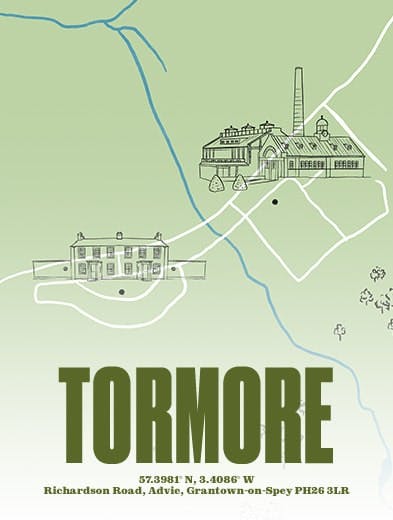Discover the Tormore distillery


Discover the Tormore distillery
Scotch whisky
Located at the edge of Cairngorms national park, Tormore distillery stands on the banks of the Spey, bordered by a vast conifer forest. Built between 1958 and 1960 by Alexander Cullen (1892-1963) and Sir Albert Richardson (1880-1964), Tormore’s architecture clashes with the traditional style of Scottish distilleries, with its weathered copper roofs, granite facades dotted with small-paned windows, and imposing musical clock.
A symbol of modernity at the time of its construction, it was built to respond to the strong demand for blends in the 1960s, and has been a listed building since 1986. Elixir Distillers — founded by brothers Singh and Tormore’s owners since 2022 — plans to restore the entire facility, open a visitor centre, and launch a new official range of products in 2026.
◊ Before even entering the distillery, the gardens are worth a stroll. Its lawns and paths are lined with topiaries, giving it the air of an aristocratic residence. The topiaries themselves are shaped like stills, streamers, and bells — the latter a reference to the distillery’s clock, which plays traditional Scottish melodies each quarter of an hour, day and night.
◊ Inside the facility, several original pieces of equipment are still in use, including the eight great malt silos installed in 1959. The high-ceilinged stillhouse still has its original single-pane windows, explaining why it remains quite cold during the winter despite the intense heat from the four pairs of pot stills.
◊ Tormore’s six cellars house over 60,000 casks of whisky, with the oldest having been filled in 1973. This is also where the historic stocks of Navy rum are kept: a Caribbean treasure in the very heart of Speyside! These sandstone jars contain rums served daily by the Royal Navy to its shipmen until July 31, 1970. This date, known as Black Tot Day, was the last time rum was officially distributed aboard British ships.
◊ Some 2,000 rum casks from Trinidad and Tobago, Guyana, Jamaica, and other tropical lands reside within Tormore’s cellars. They are used by Elixir Distillers to produce a contemporary interpretation of Navy rum. Enjoying a glass of this rum (named Black Tot) in the cold and humid Scottish climate is an unforgettable experience.
◊ Elixir Distillers cellar-master Oliver Chilton has two overriding passions: spirits and coffee. While studying philosophy in university, Chilton worked in a coffee shop and traded his espressos for whisky tastings at the bottle store across the street… and ended up working there instead. Brazilian Cattura, Kenyan SL28, Panamanian Geisha, Reunion Island Bourbon pointu… feel free to ask him which coffee variety would pair best with Tormore single malt.
◊ Across the Allt an Torra Mhoir river stands a row of cottages lining Richardson Road, named after Tormore’s lead architect. In the spirit of model villages, these cottages were built to house distillery employees. Quite remarkably for the time, each residence came equipped with a direct telephone line to the distillery: a rarity in the 1960s. Today, the cottages are available for visitors to rent.
◊ Curious visitors wishing to prolong their stay should take a deeper look at Sir Albert Richardson’s work. A major figure of British classical architecture who once presided the Royal Academy, Richardson built and restored many emblematic British buildings. Notable designs include the headquarters of the Financial Times, which was built at the same time as Tormore distillery.
◊ A novel by Neil M. Gunn (1891-1973) would make for a perfect travelling companion. One of many Scottish personalities associated with the distillery’s history, it is said that Gunn suggested the location and the name Tormore, in reference to the loch from which its water is drawn.
Tormore, Single Malt
Tormore, Single Malt
